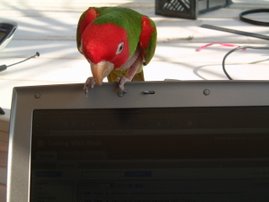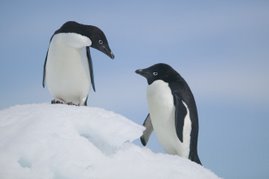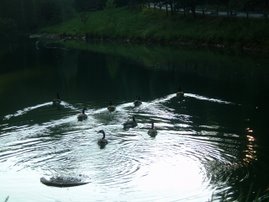Tuesday, May 10, 2011
Screaming, Screeching Bird Help - Part One
First you will take notice of the screaming details: Where exactly is the bird when it occurs - and I do mean "exactly". Is he in a specific spot on his perch, cage, etc.? Where exactly is everyone and anyone else in the home? What is going on in the home (music playing, TV on, kids around, someone talking on the phone, water running (where), food cooking (what kind), lighting, etc. Seriously, if you want to figure this out and find a calm and quiet way to live in joyous harmony with your screamer, then start a journal. Do this for a full week and include as much detail as you are willing to manage. Include details about what physical activity for the bird preceded and followed the screaming episode. Then come back to www.talkingwithbirds.blogspot.com to read "Screaming Bird Help - Part Two". We will discuss the patterns that may be emerging from your screaming journal.
Our pretty little parrot has devised his own way to train and control us by the way he uses screaming, among several other activities. Through my observations and conversations with him, I have been able to build some balance, peace, and fun in to our communal living situation (human-bird).
Our precious feathered friend has been with us for nearly 30 years. So if you plan a long and happy relationship with a bird that screams a lot, this is a very worthwhile task to take on.
Saturday, May 7, 2011
H2O ~ WATER ~ AGUA
Sunday, June 22, 2008
What Spock Has Been Up To...
Saturday, December 15, 2007
Bird Words
Birdbrain
Chicken
Crowsfeet
Cuckoo Bird
Egghead
Featherbrain
Jailbird
Songbird
Snowbird
Hmmm. Some of these even describe birds. Can you think of any others. Post your reply by clicking on "comments" below.
Monday, October 22, 2007
FEATHERS ARE:

Mr. Spock
If it has feathers...it is definitely a bird. That is to say, only birds have feathers. Furthermore, all birds have feathers...no feathers?...not a bird. While all feathers generally have the same basic elements, they can vary tremendously in appearance, shape and size. That is because different types of feathers have different functions. For example, the long and strong tail and wing feathers are primarily involved in flight. Various types of smaller and softer feathers provide insulation from water and cold.
According to wikipedia "Although feathers are light, a bird's plumage weighs two or three times more than its skeleton" http://en.wikipedia.org/wiki/Feather. That reminds me of the old riddle from when I was a kid: Which weighs more, a pound of rocks or a pound of feathers?
Sunday, October 14, 2007
Bird Toys

Wednesday, September 12, 2007
A Birdseye Vision

Birds see in color. I've known that for a long time, because our choosy Cherry-head Conure, Mr. Spock, eats his food in color order. Yes, just like a human might choose to eat jelly beans or M&Ms (click here to read about it). In fact, birds can see colors better than humans. It has to do with lenses and cones (not ice cream cones, but the cones that make up the eye), which allow them to see a greater range of the ultraviolet wavelengths than humans. That may be another reason why our pretty parrot can be found entranced with his image in anything reflective. If there is a mirror or a metallic object near by (even a spoon), he can be found snuggled up to it staring at his bright red crown and gorgeous green body. Oooh La La !!
Saturday, August 25, 2007
Parrot POW - Post Traumatic Stress Syndrome

Sunday, August 19, 2007
Sanderling: A Very Cute Seashore Bird

Friday, August 3, 2007
Why Do Birds Fly in "V" Formation?

 When late Fall rolls around, we will begin to see the migration of geese from northern areas,of the United States and Canada to the warmth of Florida and other southern states. You will recognize them as geese by their V Formation, flying long distances high in the sky.
When late Fall rolls around, we will begin to see the migration of geese from northern areas,of the United States and Canada to the warmth of Florida and other southern states. You will recognize them as geese by their V Formation, flying long distances high in the sky.The second benefit to the V Formation is that it provides the birds with good visual contact of each other. They can do a better job of making sure the flock stays together.





